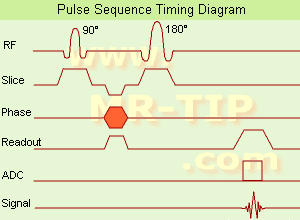 | Info
Sheets |
| | | | | | | | | | | | | | | | | | | | | | | | |
 | Out-
side |
| | | | |
|
| | | | |
Result : Searchterm 'T1 Relaxation' found in 1 term [ ] and 23 definitions [ ] and 23 definitions [ ] ]
| previous 21 - 24 (of 24) Result Pages :  [1] [1]  [2 3 4 5] [2 3 4 5] |  | |  | Searchterm 'T1 Relaxation' was also found in the following services: | | | | |
|  |  |
| |
|

(SE) The most common pulse sequence used in MR imaging is based of the detection of a spin or Hahn echo. It uses 90┬░ radio frequency pulses to excite the magnetization and one or more 180┬░ pulses to refocus the spins to generate signal echoes named spin echoes (SE).
In the pulse sequence timing diagram, the simplest form of a spin echo sequence is illustrated.
The 90┬░ excitation pulse rotates the longitudinal magnetization ( Mz) into the xy-plane and the dephasing of the transverse magnetization (Mxy) starts.
The following application of a 180° refocusing pulse (rotates the magnetization in the x-plane) generates signal echoes. The purpose of the 180° pulse is to rephase the spins, causing them to regain coherence and thereby to recover transverse magnetization, producing a spin echo.
The recovery of the z-magnetization occurs with the T1 relaxation time and typically at a much slower rate than the T2-decay, because in general T1 is greater than T2 for living tissues and is in the range of 100-2000 ms.
The SE pulse sequence was devised in the early days of NMR days by Carr and Purcell and exists now in many forms: the multi echo pulse sequence using single or multislice acquisition, the fast spin echo (FSE/TSE) pulse sequence, echo planar imaging (EPI) pulse sequence and the gradient and spin echo (GRASE) pulse sequence;; all are basically spin echo sequences.
In the simplest form of SE imaging, the pulse sequence has to be repeated as many times as the image has lines. Contrast values:
PD weighted: Short TE (20 ms) and long TR.
T1 weighted: Short TE (10-20 ms) and short TR (300-600 ms)
T2 weighted: Long TE (greater than 60 ms) and long TR (greater than 1600 ms)
With spin echo imaging no T2* occurs, caused by the 180┬░ refocusing pulse. For this reason, spin echo sequences are more robust against e.g., susceptibility artifacts than gradient echo sequences.
See also Pulse Sequence Timing Diagram to find a description of the components.
| | | |  | | | | | | | | |  Further Reading: Further Reading: | | Basics:
|
|
News & More:
| |
| |
|  | |  |  |  |
| |
|

Image Guidance
Artifacts may appear as a series of fine lines. A narrow bandwidth causes a wide read window, which allows the stimulated echo to be incorporated into the image data. This can be supported by increasing the received bandwidth, which would narrow the read window, thus not incorporating the extraneous echo. Another help would be to change the first echo time, which may change the spacing of the stimulated echoes to outside that of the read window for the second echo. | |  | |
• View the DATABASE results for 'Stimulated Echo' (8).
| | | | |  Further Reading: Further Reading: | Basics:
|
|
| |
|  | |  |  |  |
| |
|
| |  | |
• View the DATABASE results for 'Superparamagnetic Contrast Agents' (12).
| | | | |  Further Reading: Further Reading: | News & More:
|
|
| |
|  |  | Searchterm 'T1 Relaxation' was also found in the following services: | | | | |
|  |  |
| |
|
(Mn-DPDP) This agent, mangafodipir trisodium, is a hepatocyte specific MRI contrast agent. Manganese is very toxic, so it has to be chelated and put in the form of a vitamin B6 analog, which is taken up by normal hepatocytes to some extent.
Teslascan® was developed in the early 1980's, went through clinical trials in the early 1990's, and was approved in 1997. One problem with assessing the efficacy of this agent is the fact that the phase III trials finished in the early 1990's, and the techniques used for MR today are very different from the techniques used almost a decade ago.
This contrast agent shortens the T1 relaxation time. On T1 weighted pictures it makes a normal liver look brighter. Since metastases, for example, do not generally take up this agent, the contrast between the enhancing liver and the non-enhancing lesions will increase on T1 weighted pictures. It does not have much effect on T2 weighted images. Drug Information and Specification T1, Predominantly positive enhancement PHARMACOKINETIC Hepatobiliary, pancreatic, adrenal DOSAGE 5 ├é┬Ámol/kg, 0.5 ml/kg PREPARATION Finished product DEVELOPMENT STAGE Approved PRESENTATION Vials of 100 ml DO NOT RELY ON THE INFORMATION PROVIDED HERE, THEY ARE
NOT A SUBSTITUTE FOR THE ACCOMPANYING PACKAGE INSERT! Distribution Information TERRITORY TRADE NAME DEVELOPMENT
STAGE DISTRIBUTOR | |  | |
• View the DATABASE results for 'Teslascan®' (4).
| | | | |  Further Reading: Further Reading: | | Basics:
|
|
News & More:
| |
| |
|  | |  |  |
|  | | |
|
| |
 | Look
Ups |
| |